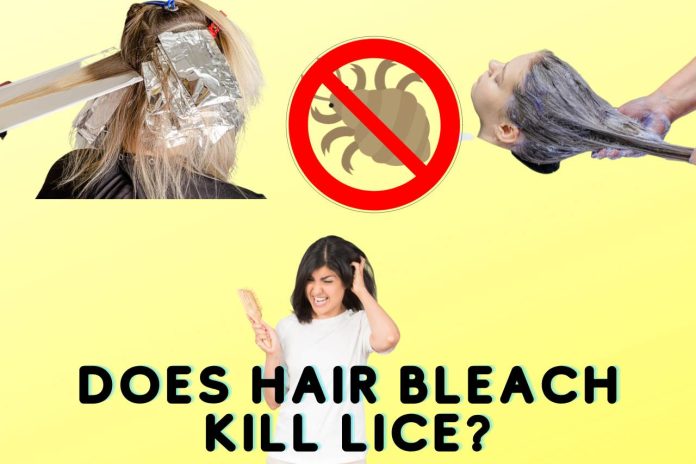Not everyone dares to embrace the fashion trend of bleaching their hair to get that ashy or golden tone. Why? Well, because bleaching products for hair contain some potent chemicals, such as hydrogen peroxide and ammonium persulfate. But you might hear somewhere that bleach kills lice; now you’re googling about does hair bleach kill lice? And how much is the authenticity of this statement genuine? Keep on reading to know all about your queries.
Lice and Nits
Nits are the eggs laid by adult lice, and head lice are small parasites that dwell on your scalp and feast on the blood. Nits might initially have a white or yellowish appearance and resemble dandruff. Nymphs get created when nits hatch. Newly born lice are called nymphs, typically small and tan in appearance. When nymphs reach adulthood, they develop into lice, which are bigger than nymphs. The size of an adult louse is comparable to a sesame seed.
Does Hair Bleach Kill Lice? – Answered
A chemical called hair bleach can make your hair’s color disappear. Hydrogen peroxide is the main component of most hair-bleaching products. So, does hair bleach kill lice? This toxin can severely harm troublesome and hardy parasites like head lice.
It gets not widely known how it is possible to eradicate head lice. Hydrogen peroxide can, to a certain extent, affect head lice, and it could even be able to destroy adults and nits. Some people think the chemical is too harsh for a few of the adults and nits, though. However, if you don’t eradicate all adults and nits, the head lice infestation won’t go away. And last but not least, don’t ignore the lice eggs because they end up growing into nymphs.
Because if you don’t remove the eggs, you might probably struggle with nits. In the event that they are not entirely eliminated and destroyed, they will ultimately hatch. The eggs’ protection makes them tough to destroy, even with chemicals used in hair bleaching, which is the problem.
Why Bleaching Your Hair is a Bad Idea?
Given the information presented above for does hair bleach kill lice, it is clear that bleaching hair is not a likely solution for getting rid of lice. Contrarily, the process could have the exact opposite result!
- Because colorful creatures and their young will be harder to notice, lice treatment may be more difficult.
- Since the eggs will subsequently hatch into adult bugs once more, the coloring pigment cannot kill the nits, rendering the removal process pointless.
As a result, you should go to the doctor as soon as you detect the critters and have them carefully removed.
The Downfall for Your Scalp
It is since both the bleaching solution and the heat from the scalp might injure the scalp. In this case, it is customary to only treat the roots of the hair after treating the rest of it.
Whether they are adults, nits, or eggs, head lice get often discovered close to the scalp. Since your blood is where they receive their sustenance, some are in the scalp. It is why treating lice breakouts with heat, such as from a flat iron, is difficult. Because head lice get usually found on the roots, the bleaching agent’s chemicals could not get kept in place long enough to eliminate all adult lice and nits. The chemicals won’t hurt the eggs either, in addition.
Usually, an adult will place the eggs close to the scalp. By doing this, you can ensure that they hatch correctly, thanks to the heat generated by your head. Usually, they would hatch in 7 to 10 days. If the head lice eggs have not yet established their nervous system, you can still destroy some of them. These are often the first eggs to get deposited. They would be able to grow their nervous system in roughly 72 hours. As a result, many protected eggs are still there and won’t get harmed by bleaching or hair coloring. These eggs will continue to be nurtured and eventually hatch if they get not removed.
What are Other Lice Treatments?
The number of home treatments for lice is roughly equal to the usual infestation’s total number of lice. Before you locate the one that works best for you, you might need to experiment with a few. Like many insects, certain lice are developing resistance to several time-tested remedies, including stearyl alcohol and medicated shampoos. The physical eradication of lice and nits using a fine-toothed lice comb is a must for all at-home treatments.
Typical home treatments include:
- Lice may get suffocated by applying mayonnaise or olive oil to the scalp. You must apply these ingredients to the hair for 24 and 48 hours while wearing a shower cap to use this folk cure, which gets scientifically confirmed. After treating the scalp, long hair may benefit from being styled in a braid or bun.
- Despite not having a scientific basis for its efficacy, coconut oil is safe and natural. Try applying it after treating your hair with vinegar to boost effectiveness.
- Essential oils like peppermint, lavender, or rosemary may repel lice. You might use essential oils combined with carrier oil as a smothering therapy.
Final Thought
Strong chemicals used in hair bleaching treatments can potentially injure the scalp and head lice. However, that does not imply that they are a successful head lice treatment. Despite their best efforts, some head lice will still survive, and the cycle will continue.
There is no certainty that killing all adult lice, nits, and eggs will be possible, no matter how many times you bleach your hair. Additionally, by bleaching repeatedly, you will endanger yourself much more. It would be advisable to avoid using hair bleaching treatments only for head lice removal.
You May Also Like


![Does Ear Wax Removal Hurt? [Explained] does ear wax removal hurt](https://tipsybeautiful.com/wp-content/uploads/2022/12/does-ear-wax-removal-hurt-218x150.jpg)


![Does Ear Wax Removal Hurt? [Explained] does ear wax removal hurt](https://tipsybeautiful.com/wp-content/uploads/2022/12/does-ear-wax-removal-hurt-100x70.jpg)

